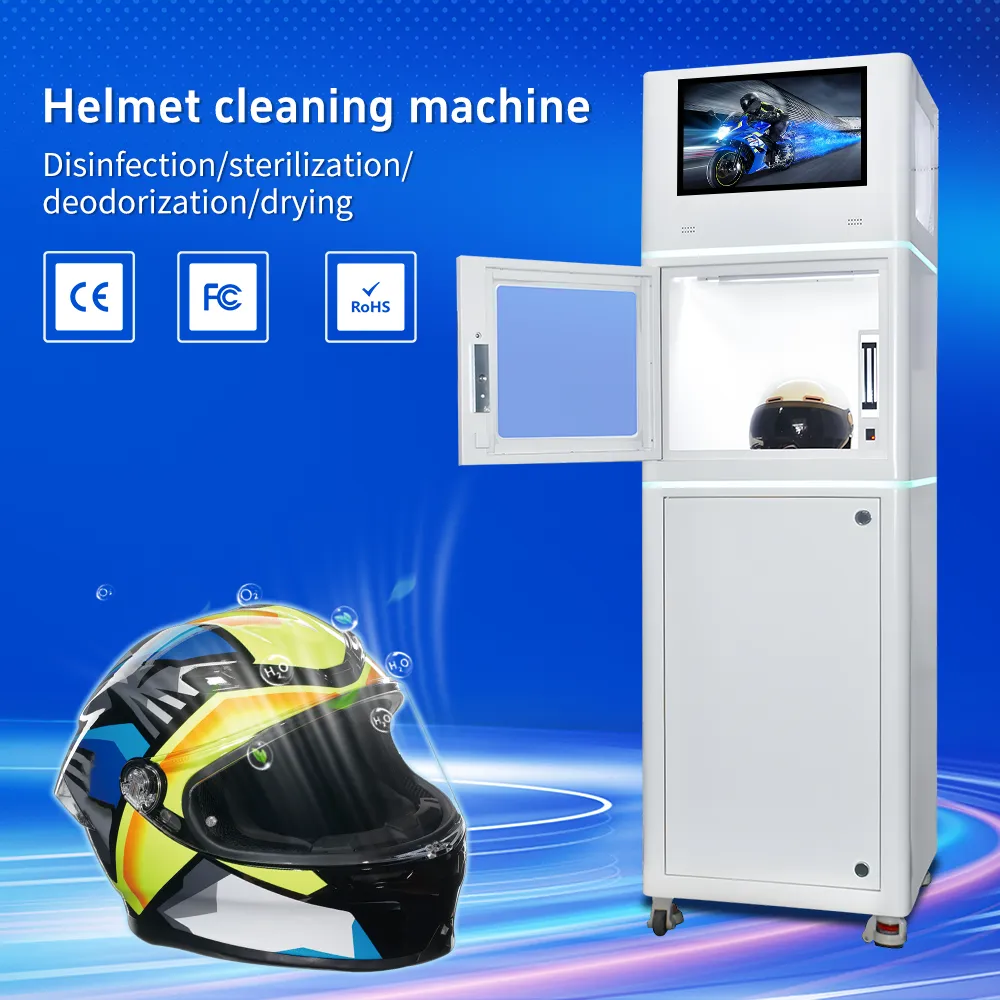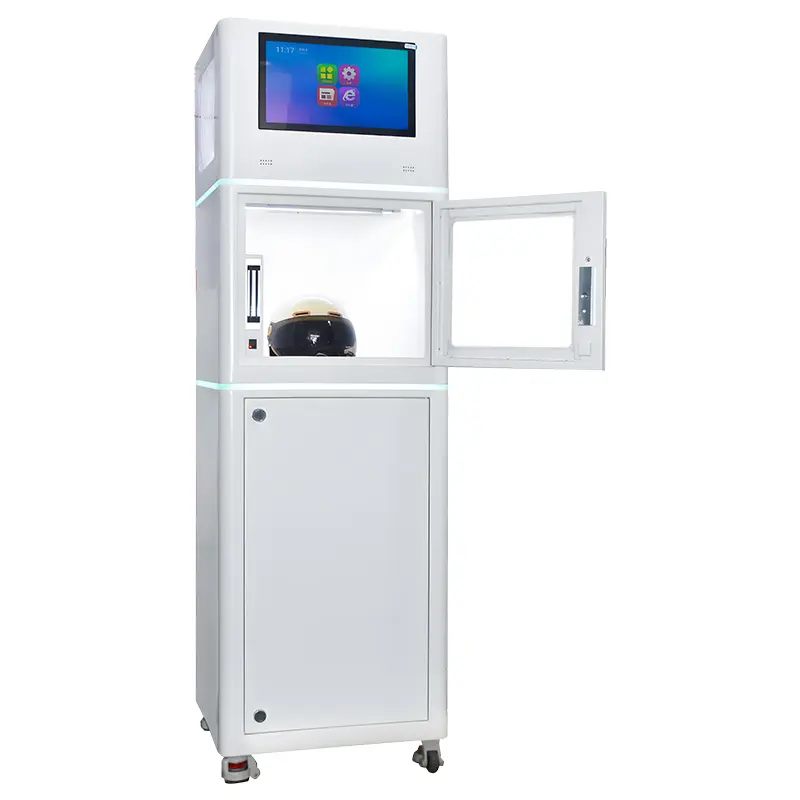The evolution of helmet cleaning
Helmet Cleaning Machines are transforming the way industries approach hygiene and safety. Traditionally, helmets used in construction, logistics, mining, and sports were cleaned manually or not cleaned regularly at all, leading to hygiene concerns, unpleasant odors, and potential health risks. Manual methods are time-consuming, inconsistent, and often ineffective. Helmet Cleaning Machines offer a modern solution that ensures helmets are cleaned, sanitized, and dried in a standardized way. This innovation not only saves time but also improves overall safety and user comfort. Businesses that adopt these machines quickly discover improvements in efficiency, compliance, and competitiveness.
Raising hygiene standards
Reliable disinfection for shared equipment
In workplaces where helmets are shared, hygiene is often a major concern. Helmet Cleaning Machines address this issue by offering reliable disinfection cycles that kill bacteria, viruses, and fungi. Traditional manual washing may remove surface dirt but cannot ensure deep sanitization. With Helmet Cleaning Machines, every user is assured of a helmet that is safe and clean. This greatly reduces the risk of infections, protects worker health, and demonstrates a company’s commitment to safety.
Odor removal for greater comfort
Unpleasant odors are a common problem with helmets, especially in industries requiring long hours of use. Sweat and bacteria accumulate quickly, leading to discomfort and reluctance to wear shared gear. Helmet Cleaning Machines remove odors during the cleaning process, restoring helmets to a fresh condition. This increases user satisfaction and ensures compliance with safety protocols, as workers are more likely to wear their gear correctly when it feels and smells clean.
Efficiency and cost savings
Saving time in high-volume operations
Manual helmet cleaning can take several minutes per unit, requiring significant labor in companies with hundreds of employees. Helmet Cleaning Machines complete the process quickly, often within minutes, and can handle multiple helmets at once. For large operations, the time saved translates directly into increased productivity. By automating cleaning, staff are freed to focus on other tasks, improving overall operational efficiency.
Reducing long-term costs
How does automation impact costs? While Helmet Cleaning Machines require an initial investment, they reduce labor expenses and extend helmet lifespan. Regular cleaning prevents material degradation, meaning helmets last longer before replacement is needed. This reduction in replacement costs, combined with lower labor demands, results in significant long-term savings. The investment pays for itself over time.
Advanced cleaning and drying technologies
Precision cleaning systems
Helmet Cleaning Machines are equipped with advanced cleaning technologies, including pressurized sprays, rotating brushes, and controlled water and detergent usage. These systems ensure even hard-to-reach areas are thoroughly cleaned. Unlike manual cleaning, which may overlook interior padding or ventilation areas, machines provide consistent results. This guarantees that every helmet, regardless of design, is cleaned to the same high standard.
Controlled drying for fast turnaround
Drying is often overlooked but critical. Damp helmets are uncomfortable and may foster mold growth. Helmet Cleaning Machines feature drying systems using heated air or dehumidification to ensure helmets are fully dry before use. This rapid drying reduces downtime and ensures helmets can be reused quickly, keeping operations running smoothly.

Ease of use and integration
User-friendly operation
Despite their advanced features, Helmet Cleaning Machines are designed for simplicity. Operators typically only need to load helmets, select a cycle, and start the machine. Intuitive controls make it easy for any staff member to use without extensive training. For businesses, this simplicity minimizes learning curves and ensures consistent results.
Integration into existing workflows
How do these machines fit into daily operations? Helmet Cleaning Machines are compact and designed to integrate seamlessly into cleaning or maintenance areas. They require minimal floor space and can be connected to existing water and power supplies. This adaptability allows businesses to introduce them without major changes to infrastructure, making adoption straightforward.
Competitive advantages for businesses adopting Helmet Cleaning Machines
Enhancing brand reputation
Investing in Helmet Cleaning Machines signals to clients, employees, and partners that a company values safety, hygiene, and innovation. This strengthens the brand image and sets the business apart from competitors. In industries where bids and contracts emphasize safety standards, having Helmet Cleaning Machines can be a differentiator that wins deals.
Extending helmet lifespan
Regular cleaning protects helmets from sweat, dirt, and chemical buildup that can degrade materials. By using Helmet Cleaning Machines, companies extend the usable life of helmets, reducing replacement frequency. This improves cost efficiency and demonstrates responsible equipment management.
Supporting workplace safety and compliance
In many industries, maintaining strict hygiene standards is not only about customer satisfaction but also about legal compliance. Helmet Cleaning Machines support businesses in meeting occupational health and safety regulations by ensuring that protective gear is always sanitary. Clean helmets reduce the risk of skin infections or respiratory issues caused by bacteria and dust. For employers, adopting Helmet Cleaning Machines shows a proactive commitment to employee welfare. This approach can also minimize liability risks and improve compliance during inspections, which further strengthens a company’s operational credibility.
Creating sustainable cleaning practices
Sustainability is another area where Helmet Cleaning Machines provide value. Unlike manual washing, which often wastes water and cleaning agents, these machines are designed to use resources efficiently. Some systems recycle air during the drying process or minimize chemical use through advanced formulations. By adopting Helmet Cleaning Machines, businesses not only save on utilities but also reduce their environmental footprint. This eco-friendly approach resonates strongly with customers and employees who prioritize sustainable practices, enhancing brand image in competitive markets.
Enhancing user experience and brand value
One of the less obvious yet highly significant advantages of Helmet Cleaning Machines is the impact they have on user experience. When employees or customers receive a freshly cleaned helmet, they immediately feel a sense of care and professionalism. Clean gear contributes to comfort by removing unpleasant odors and ensuring that interior padding feels fresh against the skin. This simple improvement in experience has long-lasting effects, as workers feel more valued and customers are more likely to trust the brand providing the equipment.
Moreover, Helmet Cleaning Machines reinforce the perception of safety and hygiene, which is crucial in industries where protective gear is shared. By consistently offering sanitized helmets, companies strengthen their reputation as organizations that prioritize well-being. This positive brand image can attract new clients, retain existing customers, and even help businesses comply with contracts or tender requirements that emphasize hygiene standards. Over time, the use of Helmet Cleaning Machines becomes not only an operational tool but also a branding asset that positions the company as a leader in innovation and responsibility.
Conclusion: A new benchmark for cleanliness and efficiency
Defining the future of cleaning services
Helmet Cleaning Machines set new standards for cleanliness, efficiency, and competitiveness in industries where helmets are essential. They improve hygiene, save costs, streamline workflows, and enhance worker comfort. By adopting these machines, businesses not only meet today’s demands but also prepare for evolving expectations in safety and operational efficiency.
Strengthening competitiveness through innovation
Companies that embrace Helmet Cleaning Machines position themselves as leaders in their fields. By combining safety, efficiency, and sustainability, these machines become more than cleaning tools—they become strategic investments. For industries ranging from construction to sports, the adoption of Helmet Cleaning Machines ensures higher competitiveness and stronger market presence.
FAQs
How do Helmet Cleaning Machines work
Helmet Cleaning Machines typically combine water jets, brushes, detergents, and disinfectants to clean helmets thoroughly. After cleaning, integrated drying systems ensure the helmets are dry, comfortable, and ready for use within minutes.
Why should businesses invest in Helmet Cleaning Machines
Investing in Helmet Cleaning Machines reduces labor costs, ensures consistent cleaning, and improves compliance with hygiene standards. They also extend helmet lifespan and enhance brand reputation, offering both operational and financial benefits.
Can Helmet Cleaning Machines handle different types of helmets
Yes, most machines are designed to accommodate a wide range of helmets, including those used in construction, mining, sports, and logistics. Adjustable settings and adaptable racks make them versatile across industries.
Which industries benefit most from Helmet Cleaning Machines
Industries such as construction, mining, transportation, sports, and equipment rental gain significant advantages. These sectors rely heavily on helmets, making hygiene, safety, and efficiency critical for daily operations.
